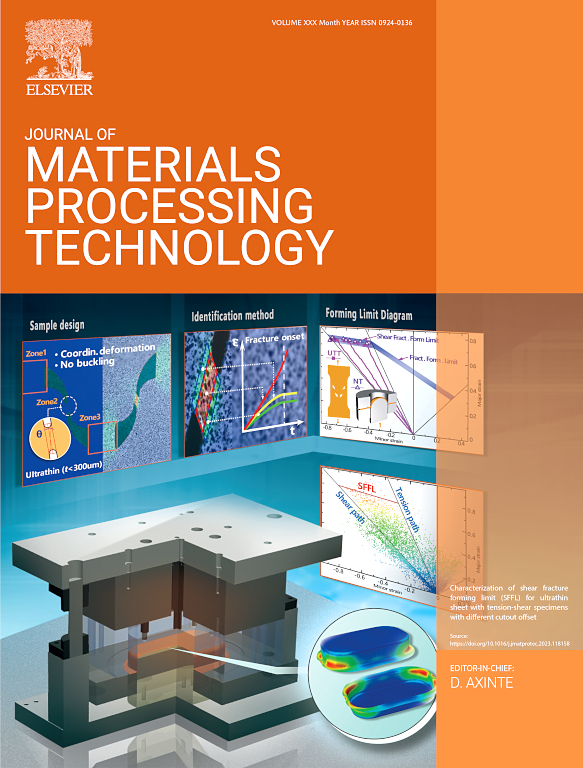基于可控扩散机制的W/(Ti/Cu)复合材料中间层/钢扩散连接接头强度增强研究
IF 7.5
2区 材料科学
Q1 ENGINEERING, INDUSTRIAL
Journal of Materials Processing Technology
Pub Date : 2025-07-09
DOI:10.1016/j.jmatprotec.2025.118978
引用次数: 0
摘要
利用两种材料的互补优势,W/钢复合结构的发展已成为推进核聚变反应堆包壳组件的重点之一。目前用于扩散连接的中间层要么不能与基体建立有效的冶金结合,要么会引起过度的反应,导致大量脆性化合物的形成。这使得W/钢复合结构的强度要求难以满足。考虑到界面处的受控化学反应有利于改善冶金结合,本文提出了“受控扩散”概念。具体而言,采用薄Ti箔和厚Cu箔的Ti/Cu复合中间层,以钢基/Cu/Ti/W基双层夹层结构扩散连接钢和W。在适当的夹层厚度设计和加工条件下,Ti夹层通过Cu夹层扩散并与钢基体发生反应,促进了Cu夹层与钢基体界面的冶金结合。Ti的活性被充分利用来解决在Cu层和钢基体之间形成牢固结合的挑战,同时降低接头中的热应力并防止脆性金属间化合物的过度形成。最后,基于可控扩散机理,成功制备了具有Ti/Cu复合层的高性能W/钢复合结构(抗拉强度为280.7 MPa)。这项工作为提高高性能结构应用中异种材料的扩散连接质量提供了一种新的层间设计概念和机理见解。本文章由计算机程序翻译,如有差异,请以英文原文为准。
Investigation on enhanced strength in W/(Ti/Cu) composite interlayer/steel diffusion bonding joint based on controlled diffusion mechanism
The development of W/steel composite structures has become one of the focuses in the advancing nuclear fusion reactor cladding subassembly, leveraging the complementary strengths of both materials. The interlayers currently used in diffusion joining either fail to establish effective metallurgical bonding with the substrates or induce excessive reactions and leading to the formation of large number of brittle compounds. This makes it difficult to meet the strength requirements of the W/steel composite structure. Considering a controlled chemical reaction at the interface is beneficial for improving metallurgical bonding, the “controlled diffusion” concept was proposed in this work. Specifically, a Ti/Cu composite interlayer with thin Ti foil and thick Cu foil was employed for diffusion bonding steel and W with the double-layer sandwich structure of steel substrate/Cu/Ti/W substrate. The Ti interlayer diffuses through the Cu interlayer and reacts with the steel substrate under appropriate interlayer thickness design and processing conditions to promote metallurgical bonding at the Cu interlayer/steel substrate interface. The activity of Ti is fully utilized to address the challenge of forming a strong bond between the Cu layer and the steel substrate, while reducing thermal stresses in the joint and preventing excessive formation of brittle intermetallic compounds. Finally, the high-performance W/steel composite structure (tensile strength of 280.7 MPa) with a Ti/Cu composite interlayer were successfully prepared based on controlled diffusion mechanism. This work provides a novel interlayer design concept and mechanistic insight for improving the diffusion bonding quality of dissimilar materials in high-performance structural applications.
求助全文
通过发布文献求助,成功后即可免费获取论文全文。
去求助
来源期刊

Journal of Materials Processing Technology
工程技术-材料科学:综合
CiteScore
12.60
自引率
4.80%
发文量
403
审稿时长
29 days
期刊介绍:
The Journal of Materials Processing Technology covers the processing techniques used in manufacturing components from metals and other materials. The journal aims to publish full research papers of original, significant and rigorous work and so to contribute to increased production efficiency and improved component performance.
Areas of interest to the journal include:
• Casting, forming and machining
• Additive processing and joining technologies
• The evolution of material properties under the specific conditions met in manufacturing processes
• Surface engineering when it relates specifically to a manufacturing process
• Design and behavior of equipment and tools.
 求助内容:
求助内容: 应助结果提醒方式:
应助结果提醒方式:


